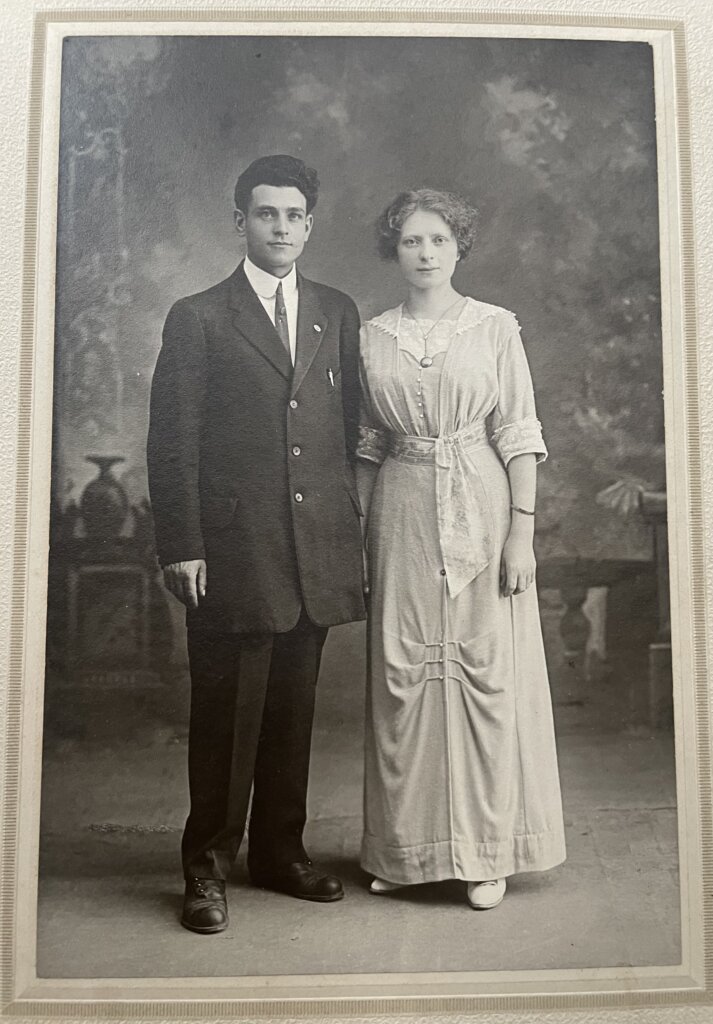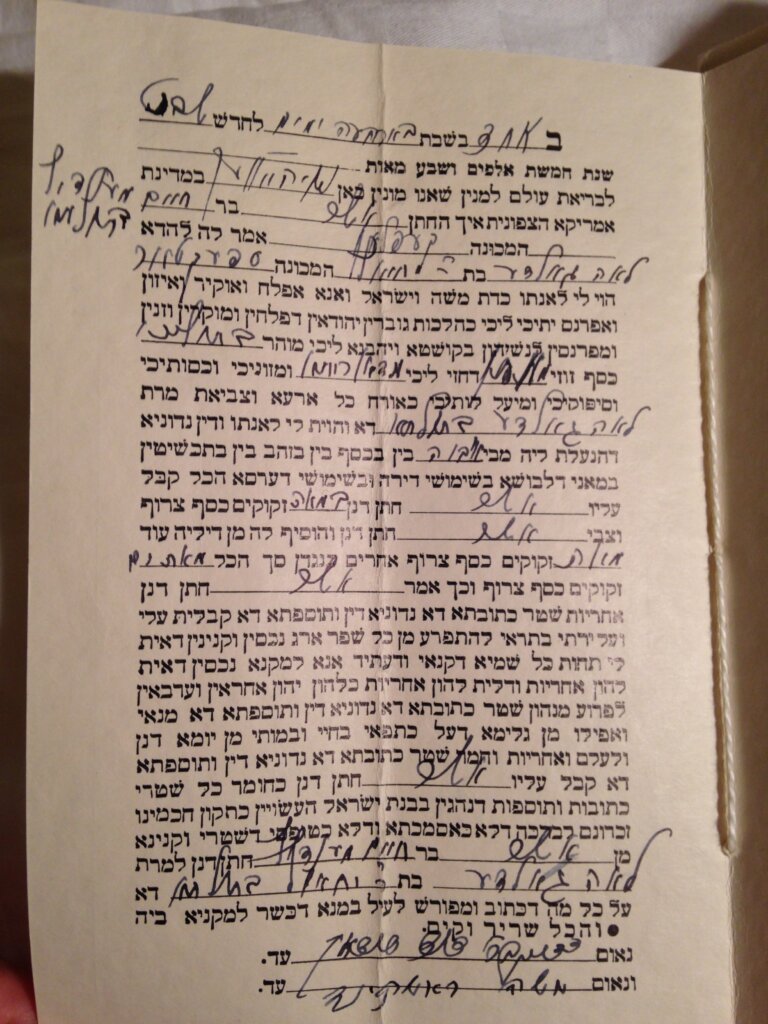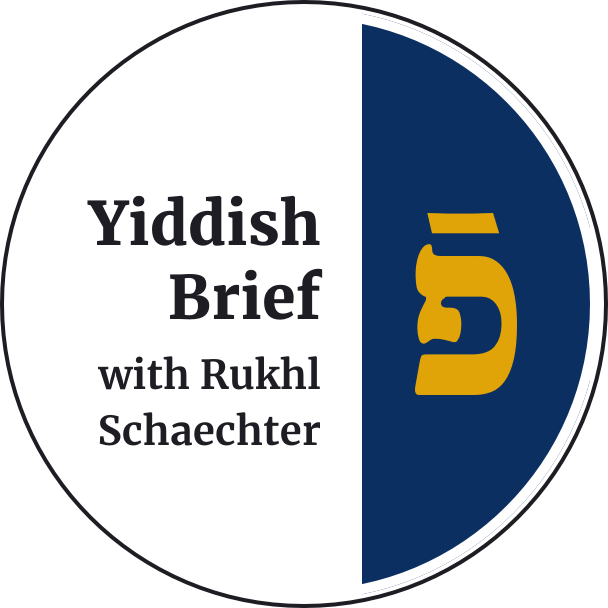Lil and Harry as newlyweds, 1940, New Haven, CT
Courtesy of the Kaplan family
My grandpa Harry fell in love with my grandma Lil at a peace demonstration. “Maybe we could get to know each other a bit better first,” she replied, when he proposed to her on their first date in leafy Edgewood Park.
In 1930’s New Haven, their families were active in the same Yiddish-speaking social clubs. He was handsome and intelligent, but she was in no rush. After all, she was a modern woman. She needed time for courtship.
Harry and Lil came from similar origins: All four of their parents had recently fled shtetls in Vilna Gobernia, Eastern Europe. Harry’s parents were from the shtetl Vasilishki and Lil’s parents — from Kurenets. Both families proudly identified as litvish (Lithuanian) Jews, a group that had a reputation for being intellectual. Though poor, they created a new American home for themselves in a tight-knit, Jewish community.
Harry’s and Lil’s generation bridged the Old World and the new, as first-generation Americans often do. Harry spoke only Yiddish, until he began kindergarten and even then, Yiddish remained their primary language. Because their parents couldn’t use Yiddish as a secret language as other Jewish parents did, they had to use Russian instead. How ironic that it was the children who consistently spoke the Jewish language. Harry easily learned fluent English, and yet they were striking a delicate balance; they were “proud of their identity,” my uncle told me.

A self-described zaftig woman, with curls that resisted taming, Lil struck Harry as exceptional. He watched her, captivated, as she stood among the demonstrators in the New Haven Green, speaking out for peace. Reeling from the losses of WWI, many Americans were simply too hesitant to enter into another world war. “She had gumption,” my uncle said of his mother.
Weeks later, on a drive with her friends, my grandma suggested: “Maybe we could see if Harry would like to join us.” “Harry?” they asked, incredulous. After all, he was so bookish and introverted. “What did Lil see in him?” they thought.
But Lil insisted. So they drove over to his house, where he was reading, probably the Scientific American, she thought. “Would you like to go for a ride?” she asked him.
“He dropped the book so fast,” she told me years later, laughing. In January 1940, they got married.
They had two weddings: the first, in New York’s City Hall, and the second was a small traditional service, with a chuppah, at Harry’s grandma Tsipe’s insistence.
Years later, I found Harry’s and Lil’s ketubah (wedding contract) in a box in Lil’s apartment. Their Yiddish names and Hebrew dates were on the left side, and English on the right. I deciphered the scribbles and loops in the handwriting in order to find out my grandfather’s Yiddish name. All these years I assumed it was Herschel, because of the initial “H” in Harry. But no, it was Usher, a variation of the Hebrew name Asher.

Their early years of marriage were blissful, until he was drafted. Despite flat feet, advanced age (31) and a pregnant wife, Harry enlisted in the spring of 1943. He served in combat for 120 days, including the deadly Battle of the Bulge. At home, Lil and her young child moved in with her parents in their small one-bedroom apartment.
Harry disarmed land mines, witnessing exploded limbs, and lives cut short. He told me about visiting a concentration camp after it was liberated. He returned home in 1945 to his young wife and first child. Through the GI Bill he could have completed his degree at Yale. Instead, he started working long days at the United Electric Union to support his new family.
Their romance spanned generations. Falling in love in the 1930’s, then the anxiety of the war years, they fell into a daily routine of raising three children on a modest field organizer’s salary. They had little spare money to pay the admission fee to the beach, yet that didn’t stop them from going swimming and picnicking in the Connecticut parks, Chatfield Hollow State Park or Lighthouse Point Park.
Many decades later, deriving naches from six grandchildren, they found harmony aging in their own condo, and later, in a one-bedroom apartment. My grandmother cooked healthy, delicious meals — noodle kugel, baked chicken, and the occasional jello mold for a party — and my grandfather did the dishes.
Even in their 90’s, they showed each other affection. He would hold her hand, she would kiss his cheek.
One day, after grandpa Harry’s health had declined sharply, our family gathered by his bed. My aunt, cousins, parents and siblings sat there, chatting, and he smiled. “We aren’t rich in money. But we’re rich in grandchildren,” he mused.
When grandpa passed away in the summer of 2006, Lil nearly died of heartbreak. But with the aid of a pacemaker, she lived nine more years, allowing her to dance at two of her grandchildren’s weddings, even to celebrate her 100th birthday. At the party, she was so elated, she danced to calypso music for hours.
At one point during that celebration, she approached the microphone and said a couple of words to her guests:
“I was always active, always trying to make things better for people. One of the things I was very strong about was equal justice for women. And that has not even been solved yet because a woman can work with a man, doing the same work, and gets less pay.
“My husband, Harry, could have been a Yale professor, but he chose to be a union organizer. And I was there with him, and I’m proud of him. He’s been gone for so many years, and I can’t forget about him. I dream about him all the time.”
As I became a young adult, Lil and I grew closer. She shared many of her thoughts and feelings with me, and how much she missed grandpa. Their love didn’t end.
”To be with a partner who loves you,” she said, “Oh — that’s a mekhaye, that’s the best.”
